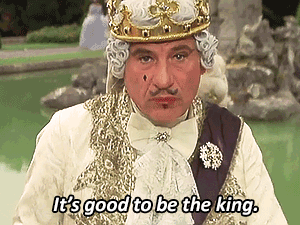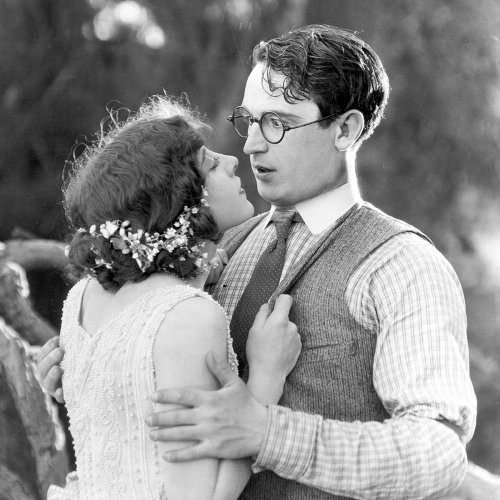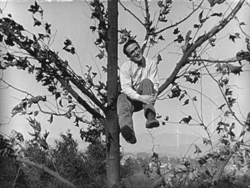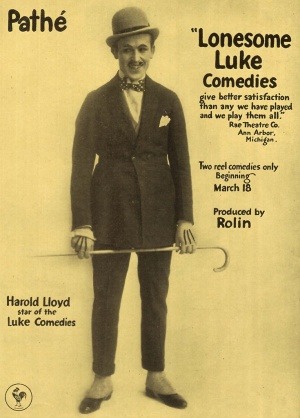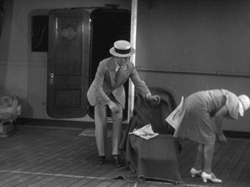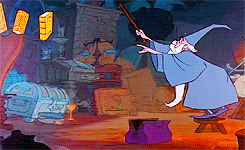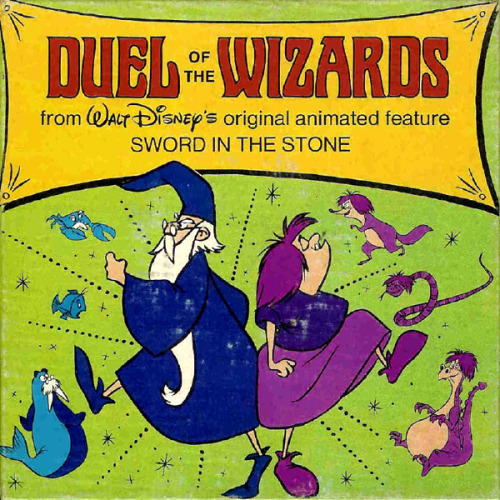As paródias são tão antigas quanto a própria
arte. Assim que a arte séria é criada, logo depois surge a paródia. Isso não
foi diferente no cinema. E, se me perguntassem quem é responsável pelas
melhores paródias da história do cinema, eu responderia em um segundo: Mel
Brooks. Mel é o homem que zoou Drácula, Frankenstein, Hitchcock, e gêneros
inteiros como o suspense e o western. E não é de se espantar que ele se
aventurasse também pelo gênero épico, no filme que, além de tudo, deu origem a
este GIF maravilhoso:
Parodies are as old as art itself. Right after serious art is created, the parody comes. This wasn’t different in film history. And, if I was asked who is responsible for the best film parodies ever, I’d answer in a second: Mel Brooks. Mel is the man who mocked Dracula, Frankenstein, Hitchcock and whole genres such as thriller and western. So we should expect that Mel mocked also the epic genre, in a film that, besides everything, gave us this wonderful GIF:
Começando com a pré-história (com a clássica
música “Assim falou Zaratrusta”), e passando por outros quatro esquetes de
duração variável, Mel Brooks nos mostra a “evolução” do homem e também a origem
de coisas como a arte (e a consequente origem do crítico de arte), a música e a
comédia.
Starting with “the dawn of men” (with the classic song “Also sprach Zarathustra”), and going through four other sketches of different durations, Mel Brooks shows us the human “evolution” and also the origin of stuff such as art (and consequently, the origin of the art critic), music and comedy.
Na sequência de Roma, Mel é Comicus, um “filósofo stand-up”, que consegue a oportunidade de se apresentar no Caesar's Palace. Pelas ruas de Roma ele conhece o escravo Josephus (Gregory Hines) e a virgem Miriam (Mary-Margaret Humes).
In the Roman sketch, Mel plays Comicus, a “stand-up philosopher” Who has the chance to perform at Caesar’s Palace. In the streets of Rome he meets the slave Josephus (Gregory Hines) and the vestal virgin Miriam (Mary-Margaret Humes).
É impagável, entretanto, o musical da Inquisição,
com direito a sapateadores e freiras nadadoras ao estilo de Esther Williams.
Não chega a ser melhor que o esquete do Monty Python, mas é a melhor parte do
filme.
However, the most priceless bit is the Inquisition musical that has even tap dancers and swimming nuns inspired by Esther Williams. It’s not better than the Monty Python “Spanish Inquisition” sketch, but this is the best part of the film.
O que me incomodou neste filme é o tanto que ele é sexista. Muitas vezes as mulheres são tratadas como objetos (embora a imperatriz interpretada por Madeline Kahn também trate os homens como objetos), e focado em sexo para fazer rir, da mesma maneira que tantas comédias fazem e sofrem ainda hoje. Não posso culpar uma má fase de Mel Brooks, pois ainda nos anos 80 ele faria filmes menos explícitos e apelativos como “Sou ou não Sou?” (1983, como ator e produtor) e “SOS – Tem um louco solto no espaço” (1987, como ator e diretor).
What really bothered me in this film was sexism. It often treats women like objects (although the empress played by Madeline Kahn also treats men like objects) and it focuses on sex to make people laugh, in the same poor way many comedies do still today. I can’t say it was a bad phase for Mel Brooks, because in the 1980s he also made less explicit films such as “To be or not to be?” (1983, as actor and producer) and “Spaceballs” (1987, as actor, producer and director).
Mel convidou uma voz ilustre para ser o narrador:
Orson Welles. É verdade que a voz inconfundível de Welles só é ouvida muito
brevemente no começo de cada esquete, mas mesmo assim Welles ganhou 25 mil
dólares pelo trabalho – que foi todo gravado em uma manhã.
Mel invited an illustrious voice to be the narrator: Orson Welles. It is true that Welles’ iconic voice is only heard briefly at the beginning of every sketch, but Welles was paid 25 thousand dollars for his work – that was all recorded in a morning.
“História do Mundo – Parte 1” não é o melhor
filme de Mel Brooks, que esteve no auge nos anos 70. Mas preste atenção nos
detalhes: é neles que está a maior graça (como no cartaz do “Cavalo de Troia”). Mas Mel triunfou assim mesmo, ao interpretar
cinco papéis e ainda foi roteirista, diretor, produtor, compositor e liricista
para os dois números musicais. E ainda nos deixou com vontade de ver “Hitler no
Gelo” na parte 2.
“History of the World – Part 1” is not Mel Brooks’ best film. Mel was at his best in the 1970s. But pay attention to the details: in them you find the best jokes (like in the “Trojan Horse” poster). But Mel triumphed, playing five roles and working as writer, director, producer, composer and also songwriter for the two musical numbers. And he even made us want to see “Hitler on Ice” in Part 2.
This is my contribution to
the Mel Brooks Blogathon, hosted by Louis at The Cinematic Frontier and honoring the legend
who turns 90 today.


